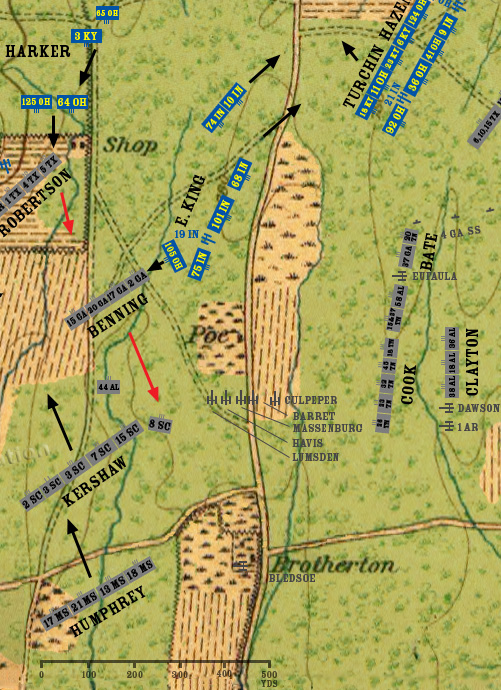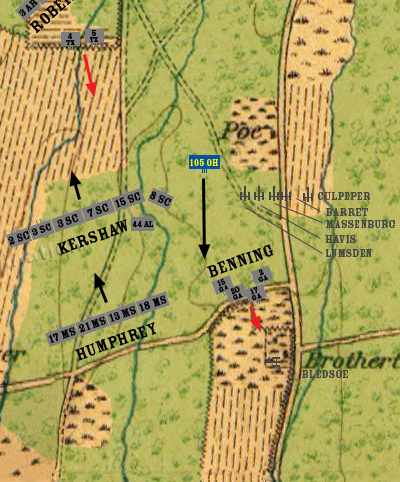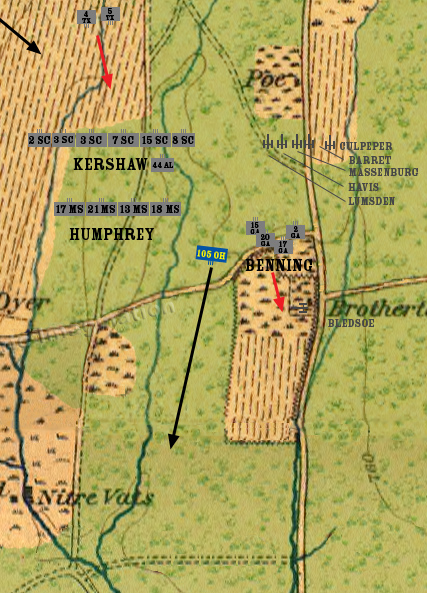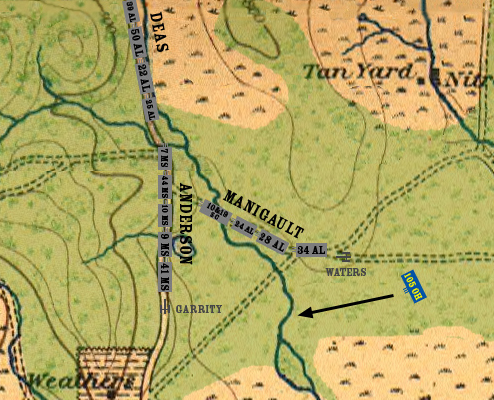
 |
|
Maps of Chickamauga The Battle Then and Now |
12:00 PM
Charge of the 105th Ohio Sept 20th The 105th Ohio had an interesting Saturday. They laid prone in reserve behind the 75th Indiana for most of the morning. After Benning’s Brigade routed Croxton to the south, the Confederates began to march north/northwest, past the right rear of Edward King’s brigade. General Reynolds himself, the division commander, ordered Major George Perkins of the 105th to wheel to the right and charge the Rebels. Reynolds’ intention was to pull back King’s brigade and link it up with the other Union forces at the Kelly Field salient. To do that, he needed to buy time.  The 105th followed. The regiment then encountered a larger Confederate unit that refused its flank to allow the 105th to pass, and a line of artillery. The artillery crew and their supports fled, and the 105th continued on. It is possible that the unit that refused its flank was Kershaw’s Brigade. Kershaw mentions pulling back the 8th South Carolina to protect his right flank. In addition, Colonel Perry left the 44th in the woods east of Dyer Field to protect his brigade’s flank, although the 8th South Carolina is the more likely candidate. The Army of the Tennessee’s Reserve Artillery was also in action near the Poe House at this time. The reports of the individual batteries are not in the Official Records, and the tablets on the battlefield do not mention them being overrun. However, this does not seem unusual since the gun crews were able to return to their pieces after the 105th passed by.  After charging at least a half mile, the regiment halted in a dense thicket after encountering a “strong line… diagonal to our front, being nearest to our left and overlapping our flank.” Here they engaged the Confederates for a time, but feeling surrounded, ran to the right to escape. There were two Confederate units in that area at that time, Manigault’s Brigade of Hindman’s Division, reforming after being routed by Wilder’s Lightning Brigade, and Trigg’s Brigade of Preston’s Division. It is not clear which one it could have been, or both. Certainly with Manigault’s men leaving to link up with the rest of their division, and Trigg’s skirmishers engaging the 105th, it would have seemed as if the Confederate were surrounding them. Despite the claims of the 105th, the engagement was likely not more than a skirmish considering the condition of the regiment after its long charge, and likely only involved Confederate pickets.  In addition, the engagement was probably shorter than the 105th reported. After breaking contact, the regiment “found our way into the rougher country west of Snodgrass Hill, the enemy we had engaged following us until we passed beyond their left flank.” They probably skirted the behind Manigault’s Brigade as it marched to rejoin Hindman, giving the appearance of following them, and then the 105th moved behind and to the left of Hindman as the Confederates marched north toward the Vittetoe farm. Near nightfall, portions of the regiment encountered the rest of Reynolds’ division as it was marching toward Rossville.  One interesting note concerning the path of the regiment’s charge, the regimental history mentions that during the charge they “were in the woods continuously, except when crossing some open roadway, until our return.” This would seem to rule out that the 105th charged across the open Poe Field, and kept to the woods during their entire journey. Remaining in the woods also squares with passing between Kershaw on the right (west) and the Reserve Artillery on the left (east), which would have been in the woods to the west of the Poe cabin. The Story of A Thousand: Being in the Service of the 105th Ohio Volunteer Infantry, in the war for the Union from August 21, 1862 to June 6, 1865 Albion W. Tourgee, 1896, pgs. 223-227. |
|
All images, text, and video © Historic Imagination Optimized for viewing at 1024 x 768 or better |
||